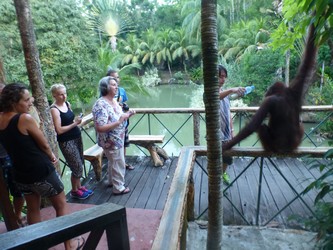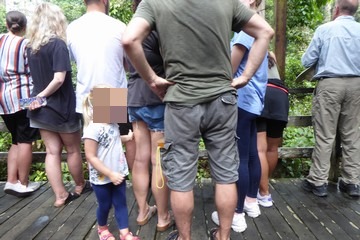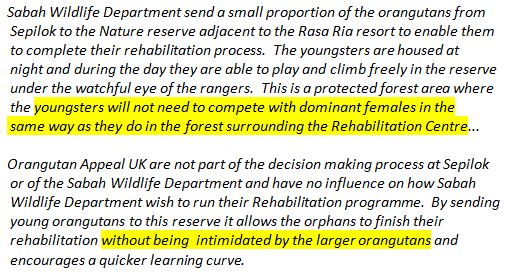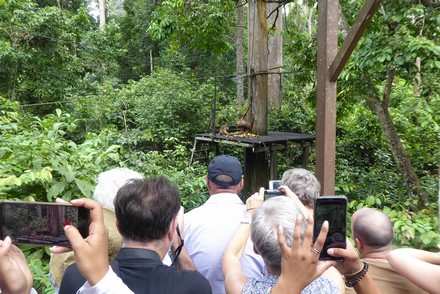Friends of the Orangutans • 9 Oct 2019 • Updated 10 Oct 2020
The Sepilok Orangutan Rehabilitation Centre (SORC) is owned by the Sabah state government and managed by the Sabah Wildlife Department (SWD), a government agency under the Ministry of Tourism, Culture and Environment (KePKAS) Sabah. At the SORC, orphan orangutans are put through a rehabilitation process to prepare them for release into a forest. The centre is at the edge of the Sepilok-Kabili Forest Reserve (SKFR), where the centre’s ex-rehabilitant orangutans (released into forest after completion of rehabilitation) co-range with wild orangutans (born in the SKFR and not ex-rehabilitants).
The SORC is open to the public for tourism. The tourism at the SORC, however, does not follow the International Union for Conservation of Nature’s (IUCN) Best Practice Guidelines for Great Ape Tourism and, as a result, negatively impacts the apes and can put tourists in danger. Below are several points from the guidelines, concerning the SORC, followed by our comments. The full guidelines are available here.
Pg. 10 – Consequently, experts recommend that no tourism be allowed with rehabilitant orangutans that are eligible for or already returned to forest life
Pg. 58 – No tourism should be allowed with reintroducable orangutans in rehabilitation centres, or in forests where rehabilitants range
The SWD and KePKAS ignore this recommendation. This advice must be adhered to minimise the risk of orangutans (both rehabilitant and ex-rehabilitant) becoming humanised (over habituation to, and/or overdependency on, humans). During twice-a-day visiting hours at the SORC, tourists can pay to enter and see orangutans eating on a platform in the SKFR. Orangutans still undergoing rehabilitation have also been seen at the platform.
For more than 15 years until early 2020, the SWD allowed members of the public to pay and be part of the rehabilitation process (another form of tourism) at the SORC, humanising the apes to humans from a young age. Humanised orangutans released into the SKFR are then exposed to large numbers of tourists daily – exacerbating the humanisation impact.
According to conservationists, the effect of humanisation on orangutans undergoing rehabilitation can, among others:
– encourage terrestriality, which has been linked to increased vulnerability to predation
– affect their nest building and foraging skills, thus hampering an orangutan’s chances of living independently in a forest
– cause the apes to lose their fear of humans and makes them far too comfortable with human presence. This can increase their proximity to humans, which in turn can increase:
– the risk of attacks on humans
– the risk of contracting disease from humans (e.g., hepatitis, tuberculosis, influenza)
– their vulnerability to poachers and hunters
The last three points above refer especially to ex-rehabilitants who have been released into a forest. All points above can have dire consequences on the future of a Critically Endangered species fighting for its survival.
Orangutans are known to roam terrestrially around the SORC. They have also been seen at hotels and other tourist attractions outside the SORC. Research has shown that tourism at the SORC can increase the risk of disease transmission to the orangutans.
While staff do try to control the crowds during visiting hours at the SORC, it is a challenge to manage the movement of every tourist and humanised orangutan, as our video shows. Tourists have been attacked at the SORC (see here and here). We have previously received reports of orangutans mugging tourists of their belongings and have been told of ‘problem’ orangutans allegedly suspiciously vanishing from the SORC; SWD and KePKAS officials did not respond when they were asked about this.

A worker at a hotel near SORC feeding an orangutan, with unsuspecting tourists present
Pg. 10 – Orangutan tourism focused on rehabilitants, especially when visited in unnatural contexts such as cages and feeding platforms and by extremely large numbers of visitors, does not meet many of the criteria that define ecotourism and as such should not be promoted as ecotourism or considered best practice.
The purpose of having a twice a day feeding sessions at the SORC is to lure orangutans to the feeding platform, to enable tourists to see and photograph them. While we’re unaware whether the SORC has been labelled as an ecotourism attraction, tour companies may label the SORC as an ecotourism destination to lure customers.
This practice is unlikely to be without consequences. A study published in 2008 has revealed that the infant orangutan death rate is higher at the SORC than in zoos. The authors of the study stated that the possible increase in disease transmission and aggression that resulted from frequent close encounters among orangutans gathered at the feeding platform might be one reason for this high death rate.
Pg. 48 – To facilitate the control of visitors, minimise danger and enhance visitor satisfaction, the number of people per party should be no more than 4 tourists accompanied by 2 guides/trackers. This should achieve a reasonable balance between apes and humans, and reduce stress and its knock-on effects.
We are not aware if there is an entry limit to SORC, but it’s certainly not four. In fact, depending on the month of the year, over ten times the recommended amount of tourists by the IUCN can be seen during a feeding session.
Pg. 49 – There should be no more than one visit per day to each group of apes (or individual/ party/forest area in the case of chimpanzee and orangutan tourism).
The SORC has twice a day feeding session. Having more than one visit per day increases the instance of humanisation and in turn, increase disease transmission and physical risks between humans-orangutans at the SORC.
Pg. 49 – All tourists and staff who are likely to approach habituated apes to within 10 metres should wear a surgical quality N95 respirator mask for the duration of their one-hour visit. Respirators that filter out higher percentages of aerosolised particles are also acceptable (i.e., N99 or N100).
Since our investigations began at the SORC nearly ten years ago until early 2020, we have never observed tourists visiting the centre being obliged to wear a face mask, and we have only rarely seen staff in charge of tourists wearing one. The COVID-19 outbreak forced the suspension of tourism at the Sepilok area in March 2019. The SORC reopened for tourism in June 2020. Although tourists have been required to wear a face mask since reopening, images show lax enforcement of this requirement. The centre suspended tourism for the second time in September 2020 following the increase in COVID-19 cases in Sabah.
The use of respirator or face masks should be made mandatory including post-COVID-19 period, and they should be worn properly at all times, because:
a) Humanised orangutans at the SORC tend to come within 10 metres of tourists. There is also photographic and video evidence of orangutans at the SORC grabbing hold of tourists. (See here and here).
b) Research has shown that tourists who are ill do visit the SORC, and this has included people showing symptoms of respiratory illness. This increases the risk of pathogen transmission to orangutans and staff.
Pg. 50 – Children below 15 years old must not be allowed to visit great apes. While parents may argue against this regulation on the basis that their child is capable of the hike or mature enough to control their fear, this safeguard is primarily for health reasons. Young people are more likely to be infected with common childhood diseases, even when properly vaccinated, and therefore pose a much greater health risk to habituated apes.
Children under the age of 15 can often be seen at the centre.

Pg. 57 – Individual orangutans should not be visited by tourists for more than 10 days per month. Tourism to individual orangutans should be suspended for at least 3 months per year. Note that if all habituated orangutans at a particular site use the same area of forest, periodic closure of the site is recommended.
SORC is open to tourism 365 days a year. Many of the same orangutans can regularly be seen at the SORC.
—
Additional note:
The Sabah Wildlife Department may argue that tourists are not allowed into areas where the rehabilitation process of SORC orangutans take place. However, for more than 15 years until early 2020, the SWD allowed members of the public to pay and be part of the rehabilitation process at the SORC, as stated above. This voluntourism practice would have humanised orphans undergoing rehabilitation for wild release. In addition, it is wrong to assume that orangutans are successfully rehabilitated when let/moved out of rehabilitation areas: they still have to learn and persistently prove that they can forage and survive independently and integrate into a forest’s orangutan community – away from tourists. This, however, may be a challenge at the SORC. A British orangutan organisation which supports the SORC made the statement below regarding the previous sending of orphaned SORC orangutans to a luxury hotel in Sabah under the guise of rehabilitation. FOTO stopped the exploitation in 2016. The highlighted parts below may refer to the effect of humanised orangutans at the SORC on orangutans undergoing rehabilitation at the centre.

Further reading about the Sepilok Orangutan Rehabilitation Centre:
No transparency from Sabah wildlife authorities on welfare concerns of 6 Sepilok orangutans
Perilous orangutan tourism resumes at Sepilok amid COVID-19 pandemic
COVID-19: Time for change at Sepilok Orangutan Rehab Centre
SWD’s dubious plan to release two orphaned Sepilok orangutans
When profits rule – Sepilok orangutan release disaster
Have questions? Click here to write to us.




